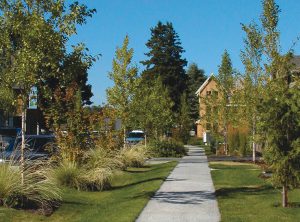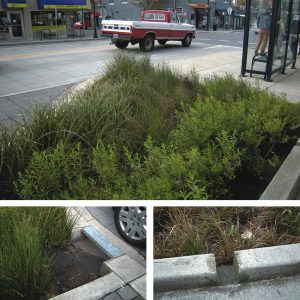Reducing the amount of storm water and load of pollutants entering the treatment system “grid” or conveyed directly to surface waters can have an immediate impact on how much money is spent to treat these waters. Part I
Britt Faucette
BioCycle August 2012, Vol. 53, No. 8, p. 36

Green infrastructure enhancements as a result of the City of Seattle’s Green Streets program have increased real estate values there by 6 percent.
Nature is the new standard. After decades, or rather centuries, striving to overcome and outwit nature, the realization that the best designs were created by nature — and continue to be — may become conventional wisdom. Identifying what these nature-based systems (natural capital) are, quantifying their performance through scientific research and inquiry, developing engineering and design criteria, establishing benefit-cost analysis tools (similar to appreciation/depreciation schedules for built capital), creating accessible applications for practitioners and professionals, and simply practicing what has been learned will define this new standard over the coming years and decades.
A “fancy” name for this work is “biomimicry,” innovation inspired by nature, according to Janine Benyus. Organics recyclers are the ultimate biomimics. Rather than extracting resources, organics recyclers must follow natural principles in order to conduct a successful business. At its root, organics recycling is a form of self-preservation and sustainability, but this behavior also restores natural cycles that have historically been broken in the course of normal business operations. Of course, by definition organics recyclers are aware that they are restoring the natural order of organic matter use and reuse, and through this process, are also reestablishing nutrient cycles, thereby transforming pollutants into resources. Where nature typically cycles organic matter and nutrients at the landscape scale, our industry has mimicked that vital ecosystem service and recreated it on a community scale. Organics recyclers will play an integral part in the coming decades in restoring these natural cycles, rebuilding natural capital and helping to improve ecosystem services.
More recently science and innovation have shown that restoring these cycles can also have a profound effect on the carbon cycle and water cycle. Mother Nature’s cycles are not exclusive, independent, closed loop systems, but are in fact synergistic by nature. Organics recycling and use decrease carbon emissions and increase sequestration via methane avoidance, soil carbon storage and permanent vegetation establishment. Rebuilding soil organic matter (a form of natural capital) and using it to reestablish native vegetation begins to restore the natural hydrologic cycle as well (an important ecosystem service). Rebuilding this natural capital leads to natural rates of storm water infiltration, peak flow, volumetric discharge, aquifer recharge, pollutant loading and evapotranspiration — all of which have a profound effect on water quality, water availability, and energy and financial resources expended on water quality and quantity.
Furthermore, cycles rely on cycles, and the interaction and synergy of these cycles working cooperatively forms more “profitable” and productive natural capital. Our new economy, driven by this type of ecosystem thinking, is no longer reliant on survival of the fittest models, but like nature, survival of the most cooperative.
An integral concept to the rapidly growing fields of Low Impact Development (LID) and Green Infrastructure (forms of sustainable storm water management and site design) is the idea of restoring the carbon cycle for the benefit of the water cycle, typically by following natural principles. The restoration of the former leads to the restoration of the latter. LID is a storm water design strategy where the post development hydrology strives to mimic the natural site condition. Green infrastructure is the implementation of LID, combined with the capture and reuse of rainwater and storm water, in an effort to take pressure off (expensive) conventional storm water conveyance and treatment infrastructure (gray infrastructure), protect and restore habitat and water quality and conserve water. “Getting off the grid” isn’t just for alternative energy gurus anymore; similar to the energy sector, storm water management now has a large voice advocating the benefits of decentralization and on-site management.
Often the adoption toward more sustainable management systems (of any kind) is slowed down over the economics versus environment debate. This is when sustainability advocates speak of life cycle costs, comparative embodied energy, internalization versus externalization of costs, the valuation of natural capital and ecosystem services, or even taxes on pollutants. While these environmental economic principles are important, actual low investment examples with immediate payback and environmental benefit are critical to rapid adoption of these practices. Direct cost comparisons between gray and green infrastructure are challenging as the former deals with the gallons of water at the end of the pipe whereas the latter prevents — or dramatically slows down — those gallons from entering the conveyance systems in the first place.
Cost Of Gray Infrastructure
The first step in the comparative analysis is to look at the current gray infrastructure system and what it costs. In many cities, storm water infrastructure is combined with the sanitary sewer system in what is aptly called a combined sewer system. Under low runoff conditions storm water is captured, combined and conveyed with sewer water before entering a wastewater treatment facility, typically a publicly owned treatment works (POTW), where the water is treated and discharged back into the environment, usually directly into a river or lake. When medium and large rainfall runoff events occur, this system of treatment often shuts down due to the large influx of storm water, thereby discharging untreated storm water and sewer water directly into these same rivers and lakes. In cities without combined sewer systems, the storm water is captured, conveyed and discharged directly into surface waters, untreated. At some point these direct storm water discharges and the combined sewer overflows (CSOs) will be treated at downstream treatment facilities because there is always a downstream water consumer (but not before polluting the water in between).
When the entire water treatment system is viewed, it becomes obvious that reducing the amount of storm water and load of pollutants entering the treatment system “grid” or conveyed directly to surface waters can have an immediate impact on how much money is spent to treat these waters. However, when the constant increase of new users connecting to the grid (population increase in towns and cities) and increasing storm water volumes and pollutant loads (more impervious surface from land conversion and urbanization to accommodate population and economic growth) are considered — plus potential regional increases in rainfall intensities and/or durations due to climate change — the challenge ahead becomes “ginormous.” Additional external costs attributable to gray infrastructure but typically left off the balance sheet (but a cost paid by someone nonetheless) include flooding and destruction of property (private and public), erosion control and habitat restoration of receiving riparian and aquatic ecosystems, carbon emissions from water treatment, energy use and carbon emissions to cool urban heat islands, and infrastructure maintenance and expansion to handle development and population increase in towns and cities.
Today, over 850 municipalities have outdated or under-designed storm water management infrastructure. The USEPA estimates that over 850 billion gallons of untreated water are discharged into the nation’s water bodies every year due to combined sewer overflows. It costs approximately $28 billion/year to convey and treat water (per unit estimates range from $0.00009 to $0.26/gallon), most of which is provided as a government service and is thereby taxpayer funded. According to the US EPA, there are currently 16,255 POTWs with 2.3 million miles of distribution pipe, and the cost to build a new one is about $22 million. The average treatment facility (serving 90,000 customers) spends $610,000/year on chemicals for water treatment, and since chemicals rely heavily on oil for manufacture and distribution, as oil prices increase so do our water treatment costs.

Portland, Oregon has reduced combined sewer overflows by 3.5 billion gallons/year, or 35 percent, and saved more than $300 million in gray infrastructure expansion costs by installing tools such as rain gardens that have cut outs along the sidewalk and street to direct storm water into the gardens.
It also takes energy to treat the polluted water. About 4 percent of the total electricity consumed in this country is used to treat and convey water. In actual numbers it is estimated that 50 million megawatts of electricity are used every year just to treat and convey wastewater (or about 2 kWh per 1,000 gallons). At the national average cost of $0.13 kWh, this equates to $6.5 billion in energy costs. Furthermore, this cost comprises 30 percent of the operating budget of U.S. water utilities — and 85 percent of their greenhouse gas emissions (Wallis-Lage and Chevrette, 2012). The carbon dioxide emitted, not including construction and maintenance of the treatment systems, has been estimated at 3030 million metric tons per year. A recent survey of water industry professionals reported that within their own industry energy use is a larger issue than water conservation and scarcity (Wallis-Lage and Chevrette, 2012).
Although all these resources are expended on water treatment, the Centers for Disease Control (CDC) says there are an average of 33 million cases of water quality related illness every year and that over $33 million annually could be saved in related health care costs by improving these water treatment systems. In 2008, the American Society of Civil Engineers estimated the cost to upgrade the nation’s water treatment infrastructure, including 600,000 miles of pipe in need of repair, was approximately $250 billion. This is up from $202 billion just four years prior. One recent industry study predicts by 2035 this cost will reach $1 trillion (Wallis-Lage and Chevrette, 2012). Perhaps the poster child for aging and under-designed storm sewer infrastructure is the City of Atlanta. After amassing over $20 million in fines from water violations, mostly from CSOs, the city has spent nearly $2 billion to upgrade its gray infrastructure, paid for by a 300 percent increase in utility fees and a sales tax hike. (Green infrastructure’s latest advocate may be Grover Norquist.)
Significant Savings
At this point it should be obvious that management strategies should be focused on reducing storm water and pollutant loads, thereby lowering pressure on current water and storm water infrastructure. The more management systems move away from natural designs the more it costs in real dollars. However, the better communities biomimic natural storm water systems, the more they can take advantage of nature’s free services. This is the essence of LID and Green Infrastructure.
A recent study examining the $5.7 billion expansion of the underground wastewater conveyance system in London found that green infrastructure implementation could eliminate CSOs and reduce the size (and expenditure) of the proposed conveyance system expansion. The City of Portland, Oregon, has reduced CSOs by 3.5 billion gallons/year, or 35 percent, and saved more than $300 million in gray infrastructure expansion costs by adopting green infrastructure measures. Washington D.C. reduced storm water treatment costs by $250,000 by choosing bioretention systems over conventional piping and filtration methods in developing an area along the Anacostia River (NCSU, 2012). A California study reported that if LID was broadly adopted across Southern California and the Bay Area it could save 72 billion gallons of water and 637 million kW of electricity, and reduce carbon dioxide emissions by 202,000 metric tons annually. If converted to kWh, at the current regional rate of $0.22/kWh, this would save over $140 million in electricity cost.
Municipal governments are not the only sector able to save money by adopting green infrastructure systems. Land developers across the U.S. have been able to reduce cost and increase real estate value by adopting Low Impact Development measures. In the Pacific Northwest a residential developer saved nearly $70,000/mile ($800/home) by replacing curb and gutter and storm sewer piping with a series of bioswales. A developer in the Upper Midwest saved over $750,000 in storm water management costs by increasing green space and implementing LID practices, while one in the southern U.S. saved $4,800/lot, and received $3,000 more once sold, also by increasing green space and implementing LID concepts (US EPA, 2007). Similarly, studies in Mary-land and Illinois have shown a cost savings of $3,500 to $4,500/lot when choosing LID over conventional storm water infrastructure in residential development.
In some cases, these cost savings are also realized by the builder or homeowner. If storm water utility fees are levied, these properties pay a lower storm water tax. Decreased site impervious surface and increased vegetation has been shown to lower energy bills between 33 and 50 percent by reducing cooling and heating costs (NCSU, 2012). As an example, a 5,000 sq ft green roof not only reduced 71,000 gallons of storm water treatment, but also conserved 110 kWh of electricity. This led to lower summer cooling bills by $107, lower winter heating bills by $444, for a total average annual energy savings of $551 (Grant and Gallet, 2010). Add in the avoided cost to treat and pump the volume of storm water that was eliminated and the total annual savings increases to $569.
Furthermore, studies are showing that water quality improvement adjacent to real estate can increase land values by 15 percent, and flood reduction measures in a floodplain can increase real estate values by 5 percent. Green infrastructure enhancements as a result of the City of Seattle’s Green Streets program has increased real estate values there by 6 percent. In Oregon, residential implementation of LID increased home values by an average of $3,000 relative to similar homes without LID in the same region (NCSU, 2012). According to a recent study on green infrastructure and real estate values, average lake front property increases $12,935 with water clarity improvement, and as much as $17,642 for every 1 mg/L reduction in pollutants within adjacent water bodies (Grant and Gallet, 2010).
Perhaps the greatest challenge (and opportunity) lies ahead, with 42 percent of urban lands projected to be redeveloped over the next 18 years. This offers an exciting opportunity for the expansion of organics use, green infrastructure and a chance to “get off the grid.” Whether working with nature or simply being inspired by nature, (re)connecting natural cycles and/or (re)building natural capital, relying on nature’s services makes more cents than ever. That’s an idea everyone can mimic.
Britt Faucette, Ph.D., LEED AP, CPESC, is an Ecosystem Scientist specializing in organic materials research, design, and use in green infrastructure, low impact development, and water quality protection applications. When he isn’t studying nature’s systems he is typically trying to spend time in them.
References
Grant, J. and Gallet, D., 2010. The Value of Green Infrastructure: A Guide to Recognizing Its Economic, Environmental and Social Benefits. Center for Neighborhood Technology. www.cnt.org/repository/gi-values-guide.pdf.
NCSU, 2012. Low Impact Development: An Economic Fact Sheet. North Carolina State University Cooperative Extension. www.ncsu.edu/weco.
US EPA, 2007. Reducing Stormwater Costs through Low Impact Development (LID) Strategies and Practices. EPA publication number 841-F-07-006. www.epa.gov/owow/nps/lid/costs07.
US EPA, 2005. Nonpoint Source News-Notes # 75. www.epa.gov/newsnotes/
Wallis-Lage, C. and Chevrette, J. 2012. 2012 Strategic Directions in the US Water Utility Industry. Black and Veatch Inc. http://bv.com/survey/ 2012-water-utility-report.













